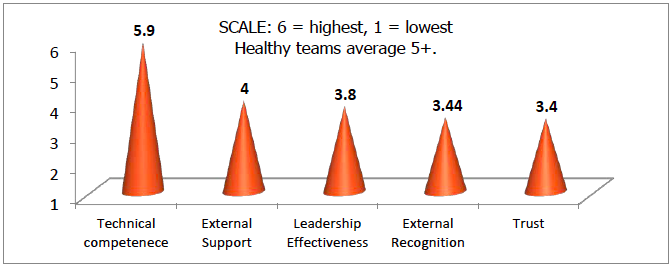How a Fractured Team Became Whole Again with 5 Dynamics
Challenge
A multi-national financial firm in a highly regulated environment depended heavily on its compliance team of 13 lawyers to guide them through all aspects of the project completion cycle, and that team had become dysfunctional. The team lead “Barbara” called 5 Dynamics® because her group had splintered into a we/they mindset. Located four time zones apart, some teammates had stopped speaking and collaborating. She had made open communication a major emphasis and couldn’t understand why her group wasn’t improving. Barbara had heard from the company’s executive team that 5 Dynamics® could catalyze rapid changes in group performance and wanted to learn more.
Action
5 Dynamics®
developed a three-part strategy: measure / meet / follow up. First, the
teammates anonymously completed our team assessment, measuring the
group’s view of its performance in terms of factors critical to their
success. The lowest scores emerged in the areas of trust, external
recognition, and leadership effectiveness. A subset of average scores
appears below:


Results
One
team member who had not spoken with Barbara in six months immediately
asked to collaborate with her on mutual coaching. Barbara called the
session “very constructive” and requested to continue working with 5 Dynamics®
to sustain the progress the team made. The two “groups” now consider
themselves one team, and collaborate productively throughout the project
completion cycle together despite (or perhaps because of) their
differences. 5 Dynamics®
was next invited to work in the general counsel’s office.
It was fascinating to me, to become more aware of my work preferences (the assessment was spot-on), and it was interesting to see my colleagues in a new light. [The] enthusiasm and insights made it all very fun but also on a more serious note I am sure the discussions will help us start to communicate and work together more productively as a team.
— Executive Director
Related Articles
Understand your Team's Dynamics
Related Links: Simpli5® your Work Life - Login Page Why use the Teams page? (simpli5.com) I need help working with a team (simpli5.com) Download the attached file below: A PDF of the activity above.Low Performing Team Rapidly Improves with 5 Dynamics
Challenge A pharmaceutical company had recently converted its clinical development teams to a matrix structure to attempt to expedite clinical trials and government approval of new drugs. The company felt that decisions were being diffused and slowed ...Focus on Team Development, Improving Working Relationships
Challenge A nonprofit health care organization serving nearly 60,000 Alaska Native and American Indian people implemented an innovative method of providing primary care that is built around the needs of the patient and a team-based method of care ...From Under-Prepared to Accelerated with 5 Dynamics
Challenge In 2002, 5 Dynamics® founder Michael Sturm worked with a high-tech company executive to develop a programmatic model to assist under-prepared (“at-risk” and “high risk”) youth to achieve their educational goals; the original target student ...MBA Students Use 5 Dynamics
Challenge One of the Top 5 business schools in the U.S. needed to modify its pivotal first-year curriculum to meet the needs of an increasingly global student body. It wanted to accelerate the learning of new students and increase their ...